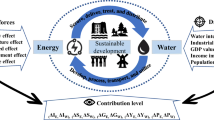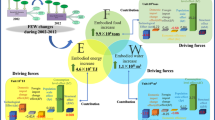Abstract
Being a node of the energy-water consumer and carbon dioxide (CO2) emitter, the household is one key sector to pilot integrated energy-carbon-water (ECW) management. This study developed an integrated framework to explore China’s provincial household ECW nexus as well as their drivers from the years 2000 through 2016. The absolute amount and growth rate of household energy use (HEU), household CO2 emissions (HCE), and household water use (HWU) were abstracted to reveal the dynamic characteristics of the household ECW nexus. Efficiency advance, income growth, urbanization, family size, and household number were defined to explain the changes in the household ECW nexus. This study revealed that there is a huge regional heterogeneity in China’s household ECW nexus. Developed regions such as Zhejiang, Jiangsu, Guangdong, and Shanghai are the most important household ECW nexus nodes with larger amounts and growth rates of household ECW. Income growth overwhelmingly increases ECW, while efficiency advance effectively curbs its growth. Comparatively, household number, family size, and urbanization have small effects. Therefore, implementing differentiated management and focusing on the synergy of socioeconomic factors are the keys to achieving integrated household ECW management. And the analytical framework can be used to analyze ECW nexus from a sector, city, or country perspective.






Similar content being viewed by others
Data availability
The datasets used and analyzed during the current study are available from the corresponding author on reasonable request.
References
Ali G, Pumijumnong N, Cui S (2017) Decarbonization action plans using hybrid modeling for a low-carbon society: the case of Bangkok Metropolitan Area. J Clean Prod 168:940–951
Ali G, Pumijumnong N, Cui S (2018) Valuation and validation of carbon sources and sinks through land cover/use change analysis: the case of Bangkok metropolitan area. Land Use Policy 70:471–478
Ali G, Abbasb S, Pana Y, Chena Z, Hussaina J, Sajjadc M, Ashrafe A (2019) Urban environment dynamics and low carbon society: multi-criteria decision analysis modeling for policy makers. Sustain Cities Soc 51:101763
Ang BW (2004) Decomposition analysis for policymaking in energy: which is the preferred method? Energy Policy 32:1131–1139
Arent D, Pless J, Mai T, Wiser R, Hand M, Baldwin S, Heath G, Macknick J, Bazilian M, Schlosser A, Denholm P (2014) Implications of high renewable electricity penetration in the U.S. for water use, greenhouse gas emissions, land-use, and materials supply. Appl Energy 123:368–377
Chen S, Chen B (2017) Coupling of carbon and energy flows in cities: a meta-analysis and nexus modelling. Appl Energy 194:774–783
Chen S, Zhu F (2019) Unveiling key drivers of urban embodied and controlled carbon footprints. Appl Energy 235:835–845
Chhipi-Shrestha G, Hewage K, Sadiq R (2017) Water–energy–carbon nexus modeling for urban water systems: system dynamics approach. J Water Resour Plan Manag 143(6):04017016
Chhipi-Shrestha G, Kaur M, Hewage K, Sadiq R (2018) Optimizing residential density based on water–energy–carbon nexus using UTilités Additives (UTA) method. Clean Techn Environ Policy 20(4):855–870
CEADs (2015) http://www.ceads.net/
Dodder R, Barnwell J, Yelverton W (2016) Scenarios for low carbon and low water electric power plant operations: implications for upstream water use. Environ Sci Technol 50:11460–11470
Fan JL, Wang JD, Zhang X, Kong LS, Song QY (2019) Exploring the changes and driving forces of water footprints in China from 2002 to 2012: a perspective of final demand. Sci Total Environ 650:1101–1111
Feng M, Liu P, Li Z (2016) Modeling the nexus across water supply, power generation and environment systems using the system dynamics approach: Hehuang Region, China. J Hydrol 543:344–359
He G, Zhao Y, Wang J, Li H, Zhu Y, Jiang S (2018) The water–energy nexus: energy use for water supply in China. Int J Water Resourc Dev 35(4):1–18
Khalkhali M, Westphal K, Mo W (2018) The water-energy nexus at water supply and its implications on the integrated water and energy management. Sci Total Environ 636:1257–1267
Lee L, Wang Y, Zuo J (2021) The nexus of water-energy-food in China’s tourism industry. Resour Conserv Recycl 105157
Li H, Zhao YH, Qiao X, Liu Y, Cao Y, Li Y, Wang S, Zhang Z, Zhang Y, Weng J (2017) Identifying the driving forces of national and regional CO2 emissions in China: based on temporal and spatial decomposition analysis models. Energy Econ 68:522–538
Li H, Lin J, Zhao YH, Kang JN (2019a) Identifying the driving factors of energy-water nexus in Beijing from both economy- and sector-wide perspectives. J Clean Prod 235:1450–1464
Li H, Zhao YH, Lin J (2019b) A review of the energy–carbon–water nexus: concepts, research focuses, mechanisms, and methodologies. WIREs Energy Environ 9. https://doi.org/10.1002/wene.358
Li H, Zhao YH, Kang JN et al (2020) Identifying sectoral energy-carbon-water nexus characteristics of China. J Clean Prod 119436
Liao X, Chai L, Ji J, Mi Z, Guan D, Zhao X (2019) Life-cycle water uses for energy consumption of Chinese households from 2002 to 2015. J Environ Manag 231:989–995
Maupin M, Kenny J, Hutson S et al (2014) Estimated use of water in the United States in 2010. U.S. Geological Survey, Circular, 1405.
Mi Z, Meng J, Guan D, Shan Y, Song M, Wei YM, Liu Z, Hubacek K (2017) Chinese CO2 emission flows have reversed since the global financial crisis. Nat Commun 8(1):1712
Nawab A, Liu G, Meng F, Hao Y, Zhang Y, Hu Y, Casazza M (2019) Exploring urban energy-water nexus embodied in domestic and international trade: a case of shanghai. J Clean Prod 223:522–535
Scott CA, Pierce SA, Pasqualetti MJ, Jones AL, Montz BE, Hoover JH (2011) Policy and institutional dimensions of the water-energy nexus. Energy Policy 39(10):6622–6630
Shan Y, Liu J, Liu Z, Xu X, Shao S, Wang P, Guan D (2016) New provincial CO2 emission inventories in China based on apparent energy consumption data and updated emission factors. Appl Energy 184:742–750
Shan Y, Guan D, Zhen H et al (2018) Data Descriptor: China CO2 emission accounts 1997-2015. Sci Data 5:170201
Stokes JR, Hendrickson TP, Horvath A (2014) Save water to save carbon and money: developing abatement costs for expanded greenhouse gas reduction portfolios. Environ Sci Technol 48:13583–13591
Tantisattayakul T, Soontharothai J, Limphitakphong N, Pharino C, Chavalparit O, Kanchanapiya P (2016) Assessment of energy efficiency measures in the petrochemical industry in Thailand. J Clean Prod 137:931–941
Wang S, Hu Y, He H, Wang G (2017) Progress and prospects for tourism footprint research. Sustainability 9:1847
Xu B, Lin BQ (2017) Assessing CO2 emissions in China’s iron and steel industry: a nonparametric additive regression approach. Renew Sust Energ Rev 72:325–337
Xu B, Lin BQ (2019) Can expanding natural gas consumption reduce China’s CO2 emissions? Energy Econ 81:393–407
Xu B, Lin BQ (2020) Investigating drivers of CO2 emission in China’s heavy industry: a quantile regression analysis. Energy 206:118195
Yang X, Wang Y, Sun M, Wang R, Zheng P (2018) Exploring the environmental pressures in urban sectors: an energy-water-carbon nexus perspective. Appl Energy 228:2298–2307
Yang X, Yi S, Qu S, Wang R, Wang Y, Xu M (2019) Key transmission sectors of energy-water-carbon nexus pressures in Shanghai, China. J Clean Prod 225:27–35
Zhang C, He G, Zhang Q et al (2019) The evolution of virtual water flows in China’s electricity transmission network and its driving forces. J Clean Prod 118336
Zheng H, Zhang ZY, Zhang ZK, Li X, Shan Y, Song M, Mi Z, Meng J, Ou J, Guan D (2019) Mapping Carbon and Water Networks in the North China Urban Agglomeration. One Earth 1:126–137. https://doi.org/10.1016/j.oneear.2019.08.015
Zhou Y, Li H, Wang K, Bi J (2016) China’s energy-water nexus: spillover effects of energy and water policy. Glob Environ Chang 40:92–100
Acknowledgements
The authors are grateful to the editors and reviewers for their valuable comments.
Funding
This study was supported by the Beijing Natural Science Foundation (No. 9172015), Beijing Social Science Foundation (No. 17JDYJB010), and Joint Development Program of Beijing Municipal Commission of Education and China Scholarship Council (201806030178).
Author information
Authors and Affiliations
Contributions
Hao Li and Yuhuan Zhao contributed to the conception of this study; Lu Zheng and Song Wang contributed significantly to analysis and manuscript preparation; Hao Li, Jianing Kang, Ya Liu, and Hongxian Li performed the data analyses and wrote the manuscript; Long Shi and Yuli Shan helped perform the analysis with constructive discussions. All authors read and approved the final manuscript.
Corresponding authors
Ethics declarations
Ethics approval
Not applicable.
Consent to participate
Not applicable.
Consent for publication
Not applicable.
Competing interests
The authors declare no competing interests.
Additional information
Responsible Editor: Roula Inglesi-Lotz
Publisher’s note
Springer Nature remains neutral with regard to jurisdictional claims in published maps and institutional affiliations.
Supplementary information
ESM 1
(DOCX 392 kb)
Rights and permissions
About this article
Cite this article
Li, H., Zhao, Y., Zheng, L. et al. Dynamic characteristics and drivers of the regional household energy-carbon-water nexus in China. Environ Sci Pollut Res 28, 55220–55232 (2021). https://doi.org/10.1007/s11356-021-13924-4
Received:
Accepted:
Published:
Issue Date:
DOI: https://doi.org/10.1007/s11356-021-13924-4




